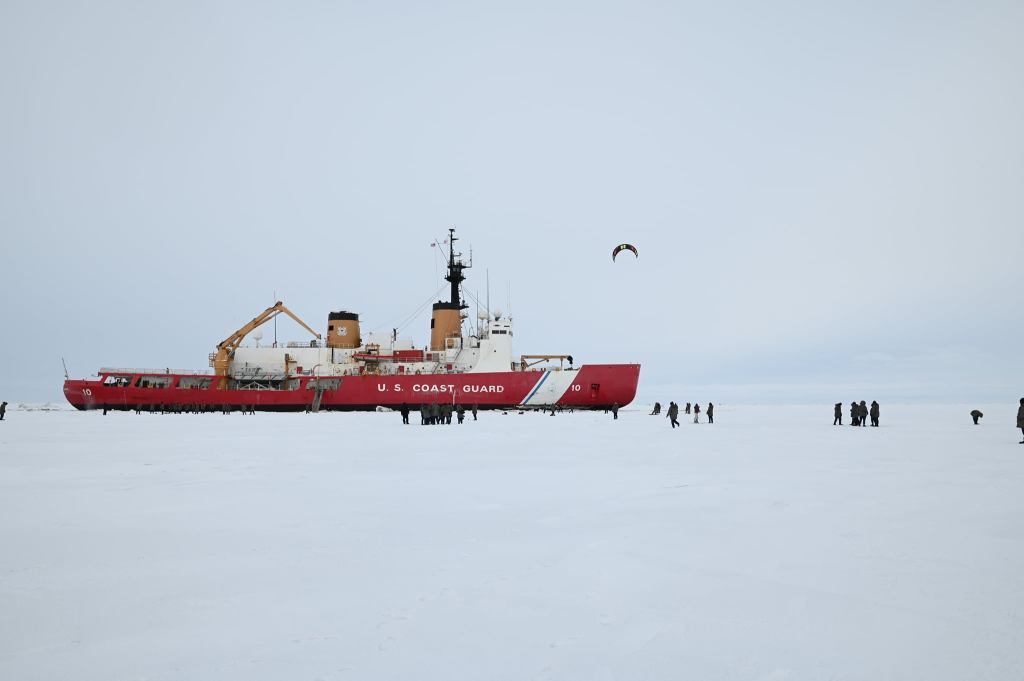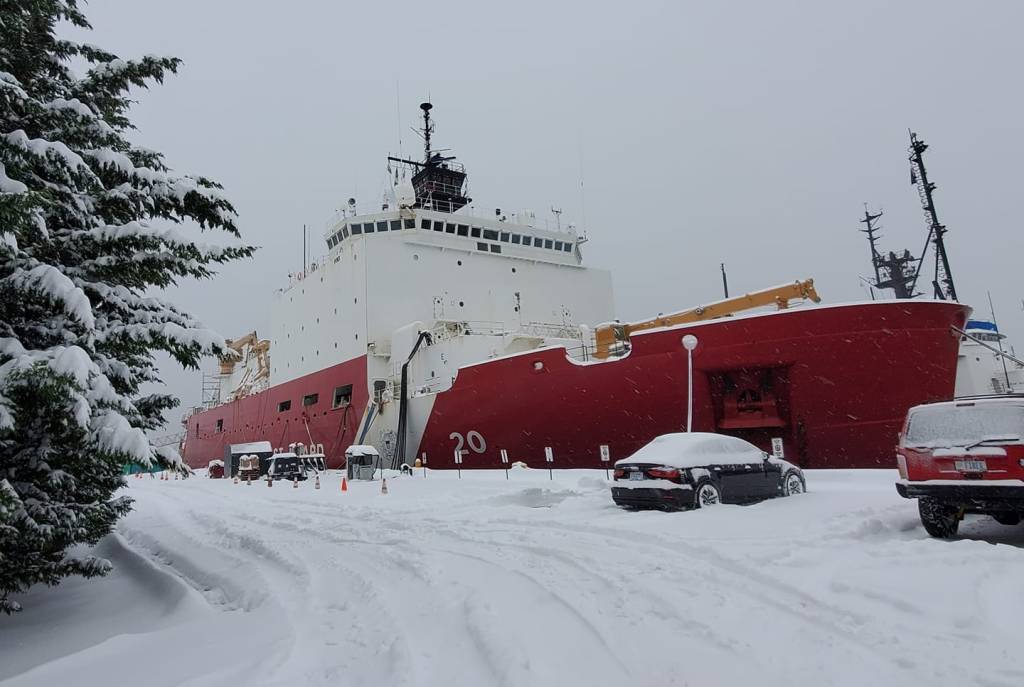Guest author Peter Ong has been asking some questions about Polar Star’s recent, unusual Arctic Winter deployment. –Chuck
—
“The Coast Guard has a long and rich history of conducting operations around the world, and international demand for increased Coast Guard capability and presence has never been greater. The Coast Guard’s diverse set of statutory missions provides the Service with unique authorities, capabilities, and partnerships that support national security and foreign policy objectives around the globe. — U.S.C.G. spokesperson, Headquarters, Washington D.C.

The U.S. Coast Guard’s sole remaining active-duty heavy Polar icebreaker, the 45-year-old USCGC Polar Star (WAGB 10), returned home to Seattle on Saturday, February 20, 2021. America’s aging icebreaker left homeport Seattle in December 2020.
Originally scheduled for “Operation Deep Freeze” to resupply McMurdo Station in the Antarctic, the Polar Star sailed north because of COVID-19 restrictions in Antarctica. This was the first time since 1982, nearly 40 years, that a heavy U.S. Coast Guard icebreaker ventured north to “Show the Flag” and support America’s presence in the Arctic. While sailing in the Bering Sea, the heavy icebreaker was armed with two .50cal M2HB heavy machine guns, armament that normally would not be mounted on an Antarctic voyage.
“CGC POLAR STAR is the Nation’s only operational heavy icebreaker and is capable of year-round deployments in the Polar Regions. Typically, CGC POLAR STAR supports the annual resupply of McMurdo Station as part of Operation Deep Freeze; however, the Coast Guard can redirect limited assets based on mission needs and priorities.” — U.S.C.G. spokesperson, Headquarters, Washington D.C.
The reason for the Polar Star’s trip was because the Coast Guard’s only medium Arctic icebreaker, 21-year-old USCGC Healy, suffered an engine room fire and starboard drive breakdown during its Arctic voyage in August 2020. Healy has since completed repairs at Mare Island Dry Dock, Vallejo, California, and has sailed back to homeport Coast Guard Station, Seattle, where it shares the docks with the heavy icebreakers Polar Star and the inactive Polar Sea (the Polar Sea suffered a crippling engine malfunction that has keep her inactive since 2010, and engine repairs were deemed too costly for the Polar Sea to ever sail again).
“CGC HEALY’s emergency dry dock is complete. Main motor repairs are continuing at CGC HEALY’s homeport in Seattle, WA to facilitate planned maintenance work. The Coast Guard anticipates all repairs will be completed by May 2021 in advance of CGC HEALY’s next scheduled deployment.” — U.S.C.G. spokesperson, Headquarters, Washington D.C.

The U.S. Coast Guard Shares “Lessons Learned” on the Polar Star’s Arctic Trip
As the first heavy U.S. icebreaker to sail into the Arctic in almost forty years (and the first US icebreaker in the Arctic during the Winter in a very long time–Chuck), what lessons have the Coast Guard and the crew of the 45-year-old icebreaker learned? When the Polar Star departed, the ship was forty-four years old; she turned forty-five over the Christmas Holidays.
U.S. Coast Guard Headquarters, Washington D.C., responded to questions via email. “Overall, this was an incredibly successful patrol for CGC POLAR STAR, as the cutter remained 100% fully mission capable for the duration of the deployment. The extreme Arctic winter environment forced the crew of CGC POLAR STAR to perform unanticipated engineering maintenance, as limitations associated with working in sub-zero temperatures affected operations. For example, extremely cold temperatures in the engine room impacted the designed operation of several engineering systems, which required innovative adjustments to standard procedures. The deployment also identified cold-weather limitations of the MK-IV Over-the-Horizon (OTH) cutter boat. Lessons learned from operating the MK-IV OTH in these temperatures are now informing the development of operational requirements for the next generation of Polar Region small boats. Finally, the winter deployment revealed the potential need to adjust electronic sensor systems to operate in extremely cold weather.”

Since the USCGC Healy’s repairs are planned to finish in May, 2021, the Polar Star may return to its usually Antarctic duties, pending COVID restrictions, although Coast Guard Headquarters, Washington D.C., did not confirm this.
When asked if the U.S. Coast Guard plans to lease any private icebreakers for Arctic duties to make up for the shortage in available U.S. government icebreakers, the Coast Guard spokesperson replied, “The Coast Guard is working with the Navy to identify potential bridging strategies that would increase U.S. surface presence in the Arctic prior to delivery of the first Polar Security Cutter.”
Chuck’s comments. Thanks to Peter Ong for sharing this with us.
I was a bit surprised by this, “… the heavy icebreaker was armed with two .50cal M2HB heavy machine guns, armament that normally would not be mounted on an Antarctic voyage.” There is no reason the Polar Star should not carrier her .50 machine guns when going to Antarctica. This is what the Treaty says.
Article I
1. Antarctica shall be used for peaceful purposes only. There shall be prohibited, inter alia, any measures of a military nature, such as the establishment of military bases and fortifications, the carrying out of military maneuvers, as well as the testing of any types of weapons.
2. The present Treaty shall not prevent the use of military personnel or equipment for scientific research or for any other peaceful purpose.
There is no prohibition in the Treaty against using armed vessels in the Arctic. Historically armed Icebreakers operated in the Antarctic after ratification of the Treaty.
Under Article VII,
“All areas of Antarctica, including all stations, installations and equipment within those areas,
and all ships and aircraft at points of discharging or embarking cargoes or personnel in Antarctica, shall be open at all times to inspection by any observers designated in accordance with paragraph 1 of this article.“
but there are really no security concerns about the 100 year old technology of the .50 cal. M2. It is not that they are likely to be needed, but we seem to be imposing limitations that really don’t exist. False presumptions may unnecessarily limit our future options.

Chuck, all correct to the best of my understanding. Also, unfortunately, for several years we had to offload essentially all of our classified material before going south, the Treaty language having been interpreted as allowing Treaty member inspectors access to all spaces. This was inconvenient as during some international conflicts that developed while we were deployed we were unable to maintain adequate secure communications. The process of maintaining accountability of these materials before departure and upon return was a significant undertaking, at least it was back then. The prohibition was with regard to conducting military operations, and that did not require access to secure spaces.
Thanks for your continuing outstanding service. Regards, Jim McClelland